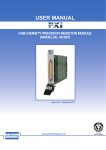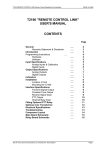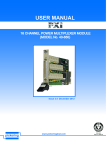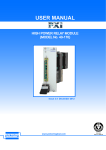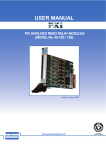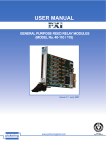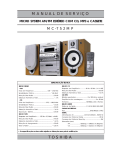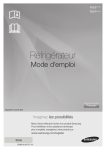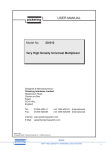Download USER MANUAL
Transcript
pickering USER MANUAL PXI RF MATRIX MODULE (MODEL No. 40-725-511 / 711 / 721 / 731 / 751) Issue 3.0 October 2007 pickering www.pickeringtest.com RF MATRIX MODULE 40-725-511/711/721/731/751 ISO 9002 Reg No. FM38792 Page pickering © Copyright (2007) Pickering Interfaces. All Rights Reserved. No part of this publication may be reproduced, transmitted, transcribed, translated or stored in any form, or by any means without the written permission of Pickering Interfaces. Technical details contained within this publication are subject to change without notice. Page ii RF MATRIX MODULE 40-725-511/711/721/731/751 pickering TECHNICAL SUPPORT For Technical Support please contact Pickering Interfaces either by phone, fax, the website or via e-mail. WARRANTY All products manufactured by Pickering Interfaces are warranted against defective materials and workmanship for a period of two years, excluding PXI chassis, from the date of delivery to the original purchaser. Any product found to be defective within this period will, at the discretion of Pickering Interfaces be repaired or replaced. Products serviced and repaired outside of the warranty period are warranted for ninety days. Extended warranty and service are available. Please contact Pickering Interfaces by phone, fax, the website or via e-mail. ENVIRONMENTAL POLICY Pickering Interfaces operates under an environmental management system similar to ISO 14001. Pickering Interfaces strives to fulfil all relevant environmental laws and regulations and reduce wastes and releases to the environment. Pickering Interfaces aims to design and operate products in a way that protects the environment and the health and safety of its employees, customers and the public. Pickering Interfaces endeavours to develop and manufacture products that can be produced, distributed, used and recycled, or disposed of, in a safe and environmentally friendly manner. Observe the Electrical Hazard Warning detailed in Section 9. Observe the Electrostatic Sensitive Device Caution detailed in Section 9. Worldwide Technical Support and Product Information http://www.pickeringtest.com Pickering Interfaces Headquarters Stephenson Road Clacton-on-Sea CO15 4NL United Kingdom Tel: +44 (0)1255-687900 Fax: +44 (0)1255-425349 E-Mail: [email protected] Pickering Interfaces Inc. 2900 Northwest Vine Street Grants Pass Oregon 97526 USA Pickering Interfaces GmbH Buchenstrasse 15 D-77880 Sasbach Germany Pickering Interfaces AB Karl Nordströmsväg 31 432 53 Varberg Sweden Tel: +1 541 471 0700 Fax: +1 541 471 8828 E-Mail: [email protected] Tel: +49 7841 66 49 10 Fax: +49 7841 66 49 12 E-Mail: [email protected] Tel: +46 340-69 06 69 Fax: +46 340-69 06 68 E-Mail: [email protected] Pickering Interfaces Inc. (East Coast Regional Office) 12 Alfred Street Suite 300 Woburn Massachusetts 01801 USA Pickering Interfaces GmbH (Munich Office) Am Mitterfeld 33 D-85622 Weissenfeld Germany Pickering Interfaces s.r.o. Smetanova 525 ˇ Trinec 739 61 Czech Republic Tel: +1 781 897 1710 Fax: +1 781 897 1701 E-mail: [email protected] Tel: +49 (0) 89 / 235 49 294 Fax: +49 (0) 89 / 235 49 292 E-mail: [email protected] Tel: +42 0558 339 168 Fax: +42 0558 340 888 E-mail: [email protected] Pickering Interfaces Sarl 6 Rue de la Mare Blanche 77186 Noisiel Marne La Vallée France Tel +33 1 60 53 55 50 Fax +33 1 60 53 55 99 email [email protected] RF MATRIX MODULE 40-725-511/711/721/731/751 Page iii pickering THIS PAGE INTENTIONALLY BLANK Page iv RF MATRIX MODULE 40-725-511/711/721/731/751 pickering CONTENTS Copyright Statement........................................................... ii Technical Support and Warranty........................................ iii Contents (this page)............................................................ v Section 1 Introduction.......................................................................... 1.1 Section 2 Technical Specification....................................................... 2.1 Section 3 Installation............................................................................ 3.1 Section 4 Programming....................................................................... 4.1 Section 5 Connector Pin Outs............................................................. 5.1 Section 6 Troubleshooting.................................................................. 6.1 Section 7 Functional Description........................................................ 7.1 Section 8 Parts List.............................................................................. 8.1 Section 9 Warnings and Cautions..................................................... 9.1 RF MATRIX MODULE 40-725-511/711/721/731/751 Page pickering THIS PAGE INTENTIONALLY BLANK Page vi RF MATRIX MODULE 40-725-511/711/721/731/751 Section 1 - introduction pickering SECTION 1 - INTRODUCTION GENERAL The 40-725-511/711/721/731/751 RF Matrix Module forms part of the System 40 PXI Programmable Switching system. The 40-725 is an 8 x 9 RF Matrix Module suitable for switching frequencies to beyond 500MHz. The 40-725 is provided in either 50Ω or 75Ω versions with a choice of coaxial connectors. It is intended for the easy construction of high performance bidirectional matrix switching systems. Automatic Isolation Switches are located on all coaxial connectors (refer to drawing), these disconnect the matrix from the external test fixture. This maximises isolation and RF performance. Matrix Operation The 40-725 is a true 8 x 9 high density matrix, any combination of crosspoints may be selected. Only the signal is switched, all grounds are common. Special Version With Loopthrough on Y9 A version is available which is compatible with the VXI 30-728-721 and MAX 20 (Mobus card). This is a 75Ω matrix, but uses 50Ω SMB coaxial connectors. Also a loop thru is retained on Y9 (used for external self test). Versions The RF Matrix Module is provided in the following configurations: • • • • • 8 x 9 RF Coaxial Matrix, 500MHz Bandwidth, 50 Ω SMB Coaxial Connector (40-725-511) 8 x 9 RF Coaxial Matrix, 400MHz Bandwidth, 2 Slot Width, 75 Ω SMZ/Type 43 Coaxial Connector (40-725-711) 8 x 9 RF Coaxial Matrix, 400MHz Bandwidth, 75 Ω SMB (50 Ohm Type) Coaxial Connector (40-725-721) 8 x 9 RF Coaxial Matrix, 400MHz Bandwidth, 75 Ω 1.0/2.3 Coaxial Connector (40-725-731) 8 x 9 RF Coaxial Matrix, 400MHz Bandwidth, 75 Ω Mini SMB Coaxial Connector (40-725-751) RF MATRIX MODULE 40-725-511/711/721/731/751 Page 1. Section 1 - introduction pickering THIS PAGE INTENTIONALLY BLANK Page 1. RF MATRIX MODULE 40-725-511/711/721/731/751 Section 2 - SPECIFICATION pickering SECTION 2 - SPECIFICATION General Switching Specification RF Specification Maximum Voltage: Maximum Power: Maximum Switch Current: Maximum Carry Current: 100V DC 10W 0.5A 0.5A Characteristic Impedance: 50Ω or 75Ω On Path Resistance: Off Path Resistance: Thermal Offset: <500mΩ >108Ω <30µV Expected Life (Low Power): Expected Life (Max Power): 1x109 operations >5x106 operations Operate Time: Release Time: <1.0ms, 0.5ms typ <1.0ms, 0.5ms typ 0 dB Maximum Frequency: Typical Rise Time: 500MHz 800ps † Insertion Loss (<500MHz): V.S.W.R. (<500MHz): Isolation (<500MHz): Crosstalk (<500MHz): <3dB † <1:1.8 † >70dB >60dB Loop Thru RF Specification (1 Pole) Insertion Loss (<100MHz): V.S.W.R. (<100MHz): <1dB <1:1.05 † Matrix RF Performance is entirely dependant upon the combination of crosspoints currently selected, these figures are for one selected crosspoint on any X or Y channel only, refer to graphs. 40-725 MATRIX VSWR (RETURN LOSS) 40-725 MATRIX INSERTION LOSS -0.4 dB 1.8 11dB 1.6 13dB VSWR -1.2 dB 1 Crosspoint Set -1.6 dB -2.0 dB 1 Crosspoint Set 1.4 16dB Return Loss -0.8 dB -2.4 dB -2.8 dB 21dB 1.2 -3.2 dB 26dB 250MHz -40 dB 500MHz 1.0 40-725 MATRIX CROSSTALK -50 dB -60 dB -60 dB -70 dB -70 dB -80 dB -80 dB -90 dB -90 dB -100 dB -100 dB 250MHz 500MHz 40-725 TYPICAL STEP RESPONSE (1 Crosspoint Set) 250MHz 500MHz RF Performance Plots for 40-725 75Ω 500MHz RF Matrix Module Typical curves are shown for matrix rows/columns with 1 crosspoint set. For optimum insertion loss and VSWR (reflection) performance ensure only one crosspoint is set in any one row/column. Multiple crosspoints can be set on any one row or column but this will seriously degrade RF performance. 50% 800ps 10% 0.3ns 500MHz 40-725 MATRIX ISOLATION -50 dB 90% 250MHz 0.8ns 1.3ns Pickering Interfaces are sponsor members of the PXI Systems Alliance www.pxisa.org RF MATRIX MODULE 40-725-511/711/721/731/751 www.pickeringtest.com E-Mail [email protected] Page 2. Section 2 - SPECIFICATION pickering Programming Pickering provide kernel, VISA and IVI drivers which are compatible with Windows 2000/NT/XP operating systems, the VISA driver is also compatible with the LabVIEW RT operating system. These drivers may be used with a variety of programming environments and applications including :National Instruments products (LabVIEW/LabWindows/CVI/ Switch Executive/MAX/TestStand etc.) Microsoft Visual Studio products (Visual Basic/Visual C+) Agilent VEE Mathworks Matlab Other environments are also supported, please contact Pickering with specific enquiries. Power Requirements +3.3V +5V +12V -12V 0 320mA (typ 240mA) 0 0 Width and Dimensions Single slot 3U PXI (CompactPCI card). Except the SMZ/BT Type 43 option which is 2 slot (40-725-711). PXI & CompactPCI Compliance All Pickering Interfaces PXI modules comply with the PXI Specification 2.1. Local Bus, Interrupts, Trigger Bus and Star Trigger are not implemented. Safety & CE Compliance All modules are fully CE compliant and meet applicable EU directives: Low-voltage safety EN61010-1:2001, EMC Immunity EN61000-6-1:2001, Emissions EN55011:1998. Mating Connectors & Cabling Examples of connectors and cabling for the 40-725 are: 40-977-511-1M Cable, 50Ω SMB, Plug to Plug, 1 Meter Length. 40-977-711-1M Cable, 75Ω SMZ/Type 43, Plug to Plug, 1 Meter Length. 40-977-731-1M Cable, 75Ω 1.0/2.3, Plug to Plug, 1 Meter Length. 40-977-751-1M Cable, 75Ω Mini SMB, Plug to Plug, 1 Meter Length. Please refer to the Pickering Interfaces “Interconnection Solutions” catalog for the full list of connector/cabling options, including drawings, photos and specifications. This is available in either print or as a download. Alternatively our web site has dynamically linked connector/cabling options, including pricing, for all Pickering PXI modules. Latest Details Please refer to our Web Site for Latest Product Details. www.pickeringtest.com Connectors PXI bus via 32 bit P1/J1 backplane connector. Signals via 17 front panel mounted coaxial connectors. Product Order Codes PXI 8 x 9 500MHz Coaxial Matrix 40-725-511 SMB Version, 50Ω BT Type 43/SMZ Version, 75Ω (2 slot module) 40-725-711 40-725-731 1.0/2.3 Version, 75Ω 40-725-751 Mini SMB Version, 75Ω Special version of the 75Ω Coaxial Matrix, 400MHz Bandwidth with Loop Thru on Y9 position. 75Ω Impedance (but using 50Ω SMB connectors) 40-725-721 Operating/Storage Conditions Operating Conditions Operating Temperature: Humidity: Altitude: 0°C to 55°C Up to 95% non-condensing 5000m Storage and Transport Conditions Storage Temperature: Humidity: Altitude: Page 2. -20°C to +75°C Up to 95% non-condensing 15000m PXI Switch & Instrumentation RF MATRIX MODULE 40-725-511/711/721/731/751 Pickering Interfaces www.pickeringtest.com Section 3 - inSTALLATION pickering SECTION 3 - INSTALLATION Software Installation First install the appropriate Pickering PXI switch card drivers by running the installer program Setup.exe, either from the CD-ROM supplied, or by downloading the latest version from our website http://www.pickeringtest.com - the recommended method. There are different versions of the Setup program to suit different Windows versions and software environments. Setup is accompanied by a ReadMe file containing additional installation information. A single installation covers all cards in the System 40, System 45 and System 50 ranges. When installation completes, the installed drivers’ ReadMe file is offered for display. It can also be displayed later using a shortcut on the Programs>>Pickering menu. If you are not a LabVIEW user you should choose the “full” version, and once that has been installed run the LabVIEW Runtime Engine installer via the shortcut on the Programs>>Pickering menu. In the absence of LabVIEW the Runtime Engine is required to support the Pickering Test Panels application. Hardware Installation CAUTION Electrostatic discharge can damage the components on the module. To avoid such damage in handling the board, touch the anti-static bag to a metal part of the chassis before removing the board from the bag. Ensure that there is adequate ventilation in accordance with the PXI Specification. The module should be installed in accordance with the following procedure: 1. Ensure that the system is turned OFF but still connected to mains so that it remains grounded. 2. Choose an appropriate slot in the rack. 3. Remove the blanking plate for the chosen slot. 4. Ensure that the injector/ejector handle is in its downward position. Align the module with the card guides on the top and bottom of the slot. CAUTION Do not raise the injector/ejector handle whilst inserting the module. The module will not insert properly unless the handle is in its downward position. 5. Hold the handle whilst slowly sliding the module into the card guides until the handle catches on the injector/ ejector rail (refer to Figure 3.1). 6. Raise the injector/ejector handle until the module firmly seats into the backplane. The front panel of the module should be flush with the front panel of the chassis. 7. Screw the front panel of the module to the front panel mounting rail. 8. In a system employing MXI-3 to connect a desktop PC to a PXI chassis or to link multiple chassis, power-up the system as follows: a. For a system comprising a PC and one chassis, power up the chassis before powering up the PC. b. For a system comprising more than one chassis, turn ON the last chassis in the system followed by the penultimate, etc, and finally turn ON the PC or chassis containing the system controller. RF MATRIX MODULE 40-725-511/711/721/731/751 Page 3. Section 3 - inSTALLATION pickering Figure 3.1 - Installing the module into a PXI/Compact PCI Chassis Testing Operation Start the Test Panels application from the Programs>>Pickering>>PXI Utilities menu. If you are a LabVIEW user, run “Test Panels (LabVIEW VI)”; if not, run “Test Panels (EXE)”. A selector panel will appear, listing all installed Pickering PXI switch cards. Click on the card you wish to control, and a graphical control panel is presented allowing operation of the card. Panels can be opened simultaneously for all the installed cards. Figure 3.2 - Typical Test Panel Display Page 3. RF MATRIX MODULE 40-725-511/711/721/731/751 pickering Section 3 - inSTALLATION As an alternative to the Test Panels, the simple Terminal Monitor program PILMon (again on the Programs>>Pickering>>PXI Utilities menu) allows access to all functions of Pickering switch cards through a command-line interface. In PILMon, enter “HE” for help on it’s commands. Please note that both the Test Panels and Terminal Monitor gain exclusive access to the cards, and so only one of them can be operational at any time. RF MATRIX MODULE 40-725-511/711/721/731/751 Page 3. Section 3 - inSTALLATION pickering THIS PAGE INTENTIONALLY BLANK Page 3. RF MATRIX MODULE 40-725-511/711/721/731/751 Section 4 - PROGRAMMING pickering SECTION 4 - PROGRAMMING Programming options for Pickering Interfaces PXI Cards Software drivers are supplied for Microsoft Windows 2000/XP operating systems, with specific support for the following development environments: ● ● ● ● ● Microsoft Visual Basic Microsoft Visual C++ Borland C++ National Instruments LabWindows/CVI National Instruments LabVIEW and LabVIEW RT Windows drivers are supplied in the form of Dynamic Link Libraries, which should also be usable in any other development environment that supports them. Three different Windows drivers are available to meet particular system requirements, and should none of these be suitable there is also the option of register-level programming. Drivers are generally ‘universal’, handling all models in the System 40, 45 and 50 ranges; however some models that are not compliant with the Iviswtch class cannot be used with the pi40iv IVI driver. The pipx40 and Pilpxi drivers are also applicable to certain models in the System 41 (PXI Instruments) range - see these drivers’ System 41 support lists. Please note that this documentation is available in its most up-to-date form as HTML help files, fully hyperlinked for easy access - both pipx40 and Pilpxi documents are included in the Pipx40vpp software installation. IVI Driver for Windows - pi40iv The pi40iv IVI (Interchangeable Virtual Instrument) driver supports all Pickering Interfaces PXI switch cards that are consistent with the Iviswtch class model - as are the great majority of cards in the System 40/45/50 ranges. It integrates well with LabWindows/CVI and LabVIEW, and is fully compatible with Switch Executive. It is also usable in general-purpose programming environments such as Visual C++ and Visual Basic. Prior installation of the VISA and IviEngine from National Instruments is required for the correct installation and operation of this driver. VISA Driver for Windows - pipx40 The pipx40 driver conforms to the VISA (Virtual Instrument Software Architecture) standard for programmable instrumentation. Instrument control environments such as LabVIEW and LabWindows/CVI are based on VISA, and pipx40 support libraries are provided for them. Prior installation of VISA from National Instruments is required for the operation of this driver. Where VISA is available, pipx40 can also be used in general-purpose programming environments such as Visual C++ and Visual Basic. When IVI is not a system requirement this driver will often yield faster operation than the pi40iv driver. Direct I/O Driver for Windows - Pilpxi The Pilpxi driver accesses cards directly, without using the VISA software layer, while offering similar overall functionality to pipx40. It is most commonly used in general-purpose programming environments such as Visual C++ and Visual Basic. Operating speed of the VISA and Direct I/O drivers is generally comparable. Register-level Programming Where the supplied drivers are not suitable, register-level programming can be employed - for example: ● If the functionality of the supplied drivers does not meet the application requirements. ● If security considerations demand full source-code for the application. ● In development environments that have alternate mechanisms for accessing PCIbus. ● For operating systems other than Windows LabVIEW, LabWindows/CVI and Switch Executive are trademarks of National Instruments Corporation. Details of the above drivers is available in separate documentation. RF MATRIX MODULE 40-725-511/711/721/731/751 Page 4. Section 4 - PROGRAMMING pickering Card Architecture Sub-units Pickering PXI cards contain one or more independently addressable functional blocks, or sub-units. Sub-unit numbers begin at 1, and separate sequences are used for input and output functions. This number is used in function calls to access the appropriate block. Generally, sub-unit numbers correspond directly to the bank numbers specified in hardware documentation. Sub-unit examples: Model Configuration INPUT sub-unit #1 OUTPUT sub-unit #1 OUTPUT sub-unit #2 OUTPUT sub-unit #3 40-110-021 16 SPDT switches None 16 SPDT switches None None 40-290-121 Dual Programmable resistors + 16 SPDT switches None Resistor #1 Resistor #2 16 SPDT switches 40-490-001 Digital I/O 16-channel inputs 32-channel outputs None None 40-511-021 Dual 12 x 4 matrix None 12 x 4 matrix #1 12 x 4 matrix #2 None Sub-unit characteristics The numbers of input and output sub-units in a card can be obtained using functions from the libraries: pipx40 pipx40_getSubCounts pilpxi PIL_EnumerateSubs pipx40 pipx40_getSubType, pipx40_getSubInfo pilpxi PIL_SubType, PIL_SubInfo For further detail of how to access and use Pickering drivers the user is advised to refer to the documentation provided with the installed drivers. Page 4. RF MATRIX MODULE 40-725-511/711/721/731/751 Section 5 - PIN OUTS pickering SECTION 5 - CONNECTOR PIN OUTS Figure 5.1 provides pin outs for the RF Matrix Modules in the 40-725-511/711/721/731/751 model range. pickering pickering 1 X 2 X1 X2 X3 X4 X5 X6 X7 X8 Y1 Y2 Y3 Y4 Y5 Y6 Y7 Y8 Y9 3 4 5 6 7 8 1 2 3 4 6 5 7 9 8 LOOP THROUGH (OPTIONAL) Y 40-725-511/721/731/751 40-725-711 Figure 5.1 - RF Matrix Module 40-725-511/711/721/731/751: Pin Outs RF MATRIX MODULE 40-725-511/711/721/731/751 Page 5. Section 5 - PIN OUTS pickering THIS PAGE INTENTIONALLY BLANK Page 5. RF MATRIX MODULE 40-725-511/711/721/731/751 Section 6 - TROUBLESHOOTING pickering SECTION 6 - TROUBLESHOOTING Installation Problems The Plug & Play functionality of Pickering switch cards generally ensures trouble-free installation. If you do experience any installation problems you should first ensure that all cards are properly seated in their slots. Improperly mated cards may go undetected by the operating system, or may be detected as a card of an unknown type. They can also cause the computer to freeze at various stages in the boot sequence. If your system employs MXI-3 you should check the integrity of all MXI-3 links. When the system is powered up, and during Windows start-up, you should expect to see periodic activity on the MXI-3 RX/TX (yellow) indicators, clearing to leave only the PWR/LNK (green) LEDs illuminated. The RX/TX indicators should show activity when you attempt to access a card. Diagnostic Utility The Pickering Diagnostic Utility (accessible through the Programs>>Pickering>>PXI Utilities menu) generates a diagnostic report of the system’s PCI configuration, highlighting any potential configuration problems. Specific details of all installed Pickering switch cards are included. All the installed Pickering switch cards should be listed in the “Pilpxi information” section - if one or more cards is missing it may be possible to determine the reason by referring to the PCI configuration dump contained in the report, but interpretation of this information is far from straightforward, and the best course is to contact Pickering support: [email protected], if possible including a copy of the diagnostic report. In the “VISA information” section, if VISA is not installed it’s absence will be reported. This does not affect operation using the Direct I/O driver, and is not a problem unless you wish to use VISA. VISA is a component of National Instruments LabWindows/CVI and LabVIEW, or is available as a standalone environment. If VISA is present and is of a sufficiently recent version, the section “Pipx40 information” should present a listing similar to “Pilpxi information”. Please note that the Diagnostic Utility cannot access cards if they are currently opened by some other application, such as the Test Panels or Terminal Monitor. Table 6.1 provides a relay look-up table. RF MATRIX MODULE 40-725-511/711/721/731/751 Page 6. Section 6 - TROUBLESHOOTING pickering TABLE 6.1 - 8 x 9 RF Matrix Relay Layout LOGICAL RELAY NUMBER Page 6. CROSSPOINT PHYSICAL RELAY ISOLATION Y, X LOGICAL RELAY NUMBER CROSSPOINT PHYSICAL RELAY ISOLATION Y, X 1 Y1, X1 RL107 RL103, RL67 33 Y5, X1 RL51 RL47, RL59 2 Y1, X2 RL106 RL103, RL66 34 Y5, X2 RL50 RL47, RL58 3 Y1, X3 RL105 RL103, RL65 35 Y5, X3 RL49 RL47, RL57 4 Y1, X4 RL104 RL103, RL64 36 Y5, X4 RL48 RL47, RL56 5 Y1, X5 RL101 RL102, RL63 37 Y5, X5 RL45 RL46, RL55 6 Y1, X6 RL100 RL102, RL62 38 Y5, X6 RL44 RL46, RL54 7 Y1, X7 RL99 RL102, RL61 39 Y5, X7 RL43 RL46, RL53 8 Y1, X8 RL98 RL102, RL60 40 Y5, X8 RL42 RL46, RL52 9 Y2, X1 RL97 RL93, RL67 41 Y6, X1 RL41 RL37, RL59 10 Y2, X2 RL96 RL93, RL66 42 Y6, X2 RL40 RL37, RL58 11 Y2, X3 RL95 RL93, RL65 43 Y6, X3 RL39 RL37, RL57 12 Y2, X4 RL94 RL93, RL64 44 Y6, X4 RL38 RL37, RL56 13 Y2, X5 RL91 RL92, RL63 45 Y6, X5 RL35 RL36, RL55 14 Y2, X6 RL90 RL92, RL62 46 Y6, X6 RL34 RL36, RL54 15 Y2, X7 RL89 RL92, RL61 47 Y6, X7 RL33 RL36, RL53 16 Y2, X8 RL88 RL92, RL60 48 Y6, X8 RL32 RL36, RL52 17 Y3, X1 RL87 RL83, RL67 49 Y7, X1 RL31 RL27, RL59 18 Y3, X2 RL86 RL83, RL66 50 Y7, X2 RL30 RL27, RL58 19 Y3, X3 RL85 RL83, RL65 51 Y7, X3 RL29 RL27, RL57 20 Y3, X4 RL84 RL83, RL64 52 Y7, X4 RL28 RL27, RL56 21 Y3, X5 RL81 RL82, RL63 53 Y7, X5 RL25 RL26, RL55 22 Y3, X6 RL80 RL82, RL62 54 Y7, X6 RL24 RL26, RL54 23 Y3, X7 RL79 RL82, RL61 55 Y7, X7 RL23 RL26, RL53 24 Y3, X8 RL78 RL82, RL60 56 Y7, X8 RL22 RL26, RL52 25 Y4, X1 RL77 RL73, RL67 57 Y8, X1 RL21 RL17, RL59 26 Y4, X2 RL76 RL73, RL66 58 Y8, X2 RL20 RL17, RL58 27 Y4, X3 RL75 RL73, RL65 59 Y8, X3 RL19 RL17, RL57 28 Y4, X4 RL74 RL73, RL64 60 Y8, X4 RL18 RL17, RL56 29 Y4, X5 RL71 RL72, RL63 61 Y8, X5 RL15 RL16, RL55 30 Y4, X6 RL70 RL72, RL62 62 Y8, X6 RL14 RL16, RL54 31 Y4, X7 RL69 RL72, RL61 63 Y8, X7 RL13 RL16, RL53 32 Y4, X8 RL68 RL72, RL60 64 Y8, X8 RL12 RL16, RL52 65 Y9, X1 RL11 RL7, RL59 66 Y9, X2 RL10 RL7, RL58 67 Y9, X3 RL9 RL7, RL57 68 Y9, X4 RL8 RL7, RL56 69 Y9, X5 RL5 RL6, RL55 70 Y9, X6 RL4 RL6, RL54 71 Y9, X7 RL3 RL6, RL53 72 Y9, X8 RL2 RL6, RL52 RF MATRIX MODULE 40-725-511/711/721/731/751 Section 7 - FUNCTIONAL DESCRIPTION pickering SECTION 7 - FUNCTIONAL DESCRIPTION Mechanical Description The RF Matrix Module conforms to the 3U height (128mm) Eurocard standard. The module comprises the following: • • • • • • • CPCI Ejector Handle Front Panel mounted 50Ω SMB, or 75Ω SMZ/Type 43, SMB, 1.0/2.3 or Mini SMB connectors 107 single pole RF Ruthenium Reed Switches Two spare Reed Switches Compact PCI backplane connector PCI Bridge (U1) Control Logic The front panel is secured to the PCB by two M2.5 x 6mm pan-head posi-drive screws. RF MATRIX MODULE 40-725-511/711/721/731/751 Page 7. Section 7 - FUNCTIONAL DESCRIPTION pickering Functional Description A functional block diagram is provided in Figure 7.1. The RF Matrix Module is powered by a +5V input via Compact PCI connector J1. The interface to the user test equipment is via the front panel mounted connectors. The module comprises a PCB populated with single pole RF relays. The relays are energised via control signals from relay drivers U8 to U21. The relay drivers are addressed by PCI bridge U1 to output the required signal. PCI Bridge U1 is configured by EEPROM U2. RELAY CONTACTS RELAY COILS RELAY DRIVERS U8 TO U21 COMPACT PCI BUS CONNECTOR J1 PCI BRIDGE U1 MODULE CONFIGURATION U5, U6 AND U7 TERMINATING RESISTORS R4 TO R15 +5V 0V PCI BRIDGE CONFIGURATION U2 Figure 7.1 - RF Matrix Module: Functional Block Diagram Page 7. RF MATRIX MODULE 40-725-511/711/721/731/751 Section 8 - PARTS LIST pickering SECTION 8 - PARTS LIST The following pages provide parts lists and a component layout diagram for RF Matrix Modules. RF MATRIX MODULE 40-725-511/711/721/731/751 Page 8. Section 8 - PARTS LIST pickering Table 8.1 provides a parts list and Figure 5.1 a component layout diagram for the 40-725-511/711/721/731/751 Multiplexer Module. TABLE 8.1 - RF Matrix Module 40-725-511/711/721/731/751 Parts List PCB Location Pickering Interfaces Part Number Part Description Quantity R1, R2 C/RS/079 RESISTOR N/W 4 x 10k 1206 2 R3 C/RS/085 RESISTOR 10k 0805 1 R4 to R15 C/RS/102 RESISTOR N/W 4 x 10R 1206 12 RL1 to RL109 C/RL/115 111RF-1-A-5/2D 109 C1, C2, C7 to C37 C/CP/034 CAPACITOR 100nF 0603 33 C3 to C6 C/CP/024 CAPACITOR 10uF TANT SMD 4 J1 C/CN/355 cPCI J1 CONNECTOR 1 C/MS/071 FEMALE CODING KEY, BRILLIANT BLUE, V 1 U1 C/IC/098 PCI9050 PQFP 1 U2 C/IC/099 93CS46 DIP 1 C/IC/035 8 PIN DIP SKT 1 U3 C/IC/056 7705 SOP 1 U4 C/IC/087 74HCT32 SOP 1 U5 C/IC/100 74HCT273 SOP 1 U6 C/IC/101 74HCT244 SOP 1 U7 C/IC/090 93C56 SOP 1 U8 to U21 C/IC/108 HEF4794B SOP Page 8. RF MATRIX MODULE 40-725-511/711/721/731/751 14 Section 8 - PARTS LIST pickering Y1 U21 C30 U20 C29 U19 C28 U18 C27 U17 C26 U16 RL107 RL106 RL105 RL104 RL103 RL102 RL101 RL100 RL99 RL98 RL97 RL96 RL95 RL94 RL93 RL92 RL91 RL90 RL89 RL88 RL87 RL86 RL85 RL84 RL83 RL82 RL81 RL80 RL79 RL78 RL77 RL76 RL75 RL74 RL73 RL72 RL71 RL70 RL69 RL68 RL67 RL66 RL65 RL64 RL63 RL62 RL61 RL60 X2 X3 X4 X5 X6 X7 X8 X1 Y4 RL59 RL58 RL57 RL56 RL55 RL54 RL53 RL52 RL51 RL50 RL49 RL48 RL47 RL46 RL45 RL44 RL43 RL42 RL41 RL40 RL39 RL38 RL37 RL36 RL35 RL34 RL33 RL32 RL31 RL30 RL29 RL28 RL27 RL26 RL25 RL24 RL23 RL22 RL21 RL20 RL19 RL18 RL17 RL16 RL15 RL14 RL13 RL12 RL11 RL10 RL9 RL8 RL7 RL6 RL5 RL4 RL3 RL2 C25 C9 U15 Y5 Y9 C6 RL1 C24 C14 C8 C20 RL109 C10 C34 C4 U11 C33 U10 C32 U8 U9 C31 R5 R6 R9 C22 R2 U7 SPARE RELAYS C35 U12 R8 U6 R3 pickering U14 R7 U5 RL108 C12 C13 C23 C5 C36 U13 R4 LT C11 C37 C1 C2 U4 R11 R12 R13 C16 U3 C19 U1 C15 C21 U2 R1 J1 R10 R14 R15 C17 C18 C7 C3 Figure 8.1 - RF Matrix Module: Component Layout RF MATRIX MODULE 40-725-511/711/721/731/751 Page 8. Section 8 - PARTS LIST pickering THIS PAGE INTENTIONALLY BLANK Page 8. RF MATRIX MODULE 40-725-511/711/721/731/751 pickering SECTION 9 - WARNINGS AND CAUTIONS WARNING - DANGER OF ELECTRIC SHOCK THIS MODULE MAY CONTAIN HAZARDOUS VOLTAGES. BEFORE REMOVING THE MODULE FROM THE RACK REMOVE ALL SUPPLIES. CAUTION Handling of Electrostatic-Sensitive Semiconductor Devices Certain semiconductor devices used in the equipment are liable to damage due to static voltage. Observe the following precautions when handling these devices in their unterminated state, or sub-units containing these devices: (1) Persons removing sub-units from an equipment using these devices must be earthed by a wrist strap and a resistor at the point provided on the equipment. (2) Soldering irons used during the repair operations must be low voltage types with earthed tips and isolated from the mains voltage by a double insulated transformer. (3) Outer clothing worn must be unable to generate static charges. (4) Printed Circuit Boards (PCBs) fitted with these devices must be stored and transported in anti-static bags. RF MATRIX MODULE 40-725-511/711/721/731/751 Page 9. pickering THIS PAGE INTENTIONALLY BLANK Page 9. RF MATRIX MODULE 40-725-511/711/721/731/751




























